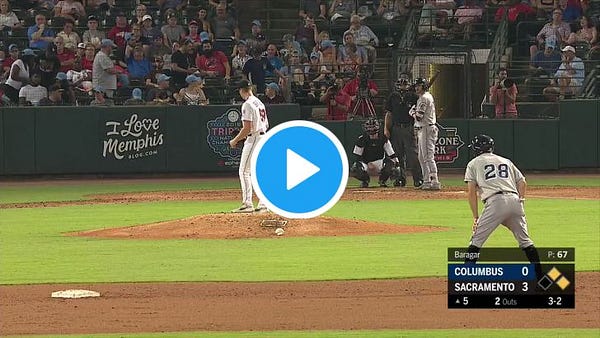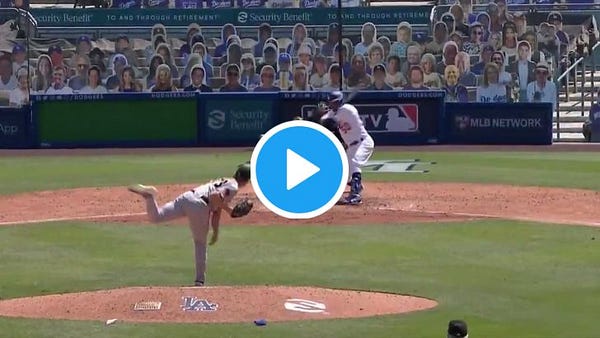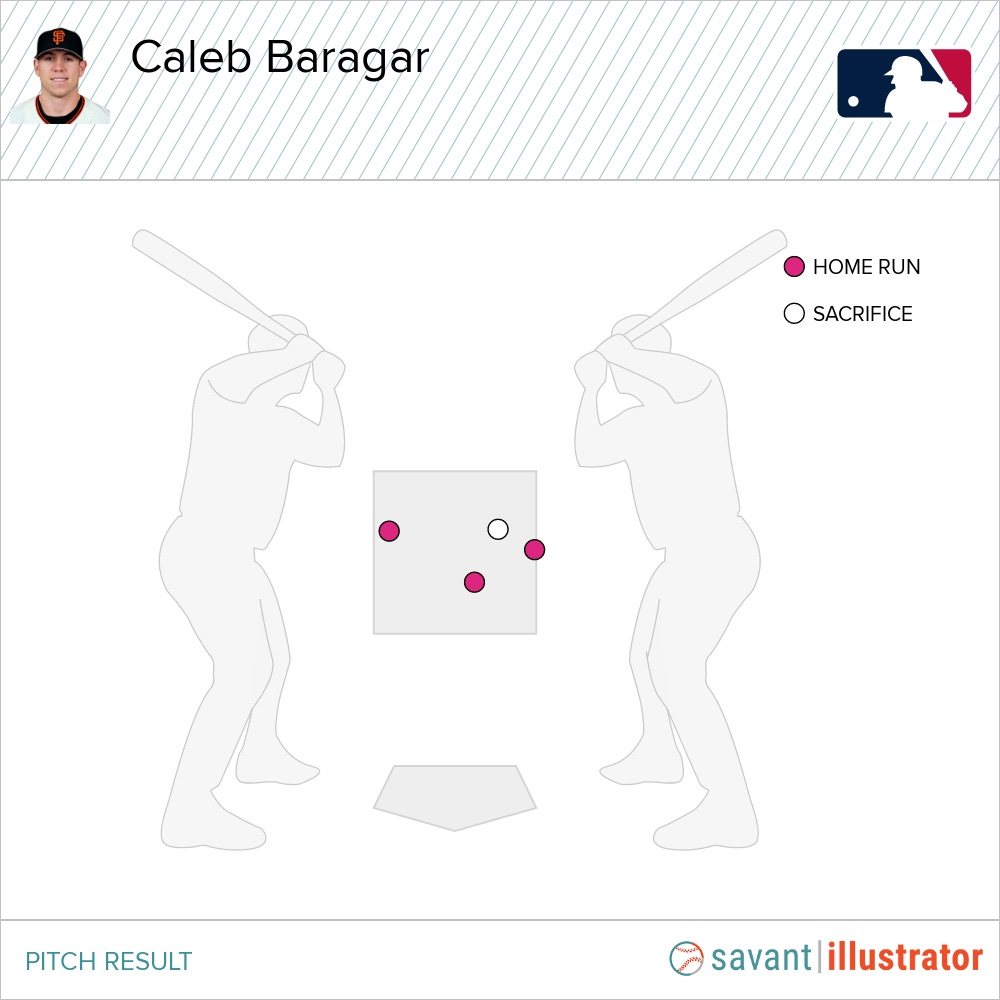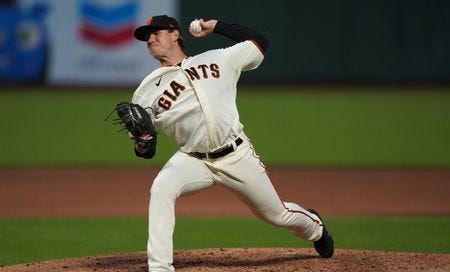This is the third in a continuing series that will look back at the 2020 season for most of the Giants rookie players. So far, we’ve covered:

Photo credit: Nhat V. Meyer/Bay Area News Group
Each of our first two installments of this series involved some bit of intellectual gymnastics seeking the silver lining of some fairly gloomy-looking clouds. But not so for today! A review of Caleb Baragar’s 2020 is fairly unalloyed goodness! With maybe a reasonable caveat or two around the edges of things. But mostly good!
To truly grasp how remarkable Caleb Baragar’s 2020 was, perhaps we need to go back a couple of years and mark his journey towards it. Talking with Richmond’s Director of Communications Trey Wilson, Baragar had this to say about his expectations coming out of Spring Training in 2019:
Honestly, I was just hoping to break with a team last year…My second year (2017), I really struggled in Augusta. So it kinda put me back a little bit in the minds of the Front Office because normally you don’t see a [college] Senior sign guy struggle in Low A. Normally they’re developed enough…But we were trying to change a bunch of things my first full season and it just didn’t go very well. And so my second year (2018) I was coming in not really knowing what was going to happen with me.
What happened with him — and this is truly extraordinary to think back upon — was that the Giants left him in extended spring training when camp broke. Then, after moving him on and off of San Jose’s active roster a couple of times in April, where he worked out of the pen, team officials told him he was being sent back to Augusta to fill a hole in their rotation. He was stunned — and no doubt nervous about his future.
This kind of movement, needless to say, is the kiss of death. This is the conversation that tells you you’re an org guy, which is but a small step away from a Cut guy, an ex-minor leaguer. He was 24. A low round senior sign out of college who was: a) sent to A ball for his first full season; b) failed there, and c) got returned there for a second season after having been left behind in extended spring training. You could not build a less inspiring start to a career if you tried. And the story didn’t take a turn for the better that year either. Baragar’s second try at the Sally still produced an ERA over 4.00, though his strikeouts did perk upwards. It’s no wonder his only real hope for 2019 was to get assigned to some team out of spring training. To get left behind would be to live in daily fear of an even worse conversation with club officials.
As it happened, he cleared that bar and then some. Assigned to San Jose out of camp, he quickly moved up to AA Richmond within a month. And from there it was a wild ride that ended in the last minor league game that we’ve ever seen played…


We know now that part of Baragar’s success in 2019 came with a boost from the analytics department, which let him know that the high spin on his fastball would play better up in the zone — knowledge he used to increase the effectiveness of his fastball. But to be clear, he still wasn’t exactly a breakout star in the system — one reason why Baragar was getting prime starts in the AAA post-season was because the Giants had promoted most everyone else. He didn’t get a non-roster invite as an extra arm in spring training. Instead the 26 year old headed back to minor league camp and when COVID-19 brought spring training to a suspended end, he stayed on in Scottsdale, looking for a workout facility to try to improve his game, and particularly to up his velocity.
When baseball resumed in July, Baragar still wasn’t quite in the organization’s sightlines — he wasn’t included on the original list 60 Player Pool (actually 54 names originally) invited to begin Summer Camp 2.0 in Oracle Park. But within the first week something changed. Perhaps it was Jarlin Garcia presumably testing positive for COVID — delaying his season start until mid-August. Perhaps it was Tony Watson’s shoulder tightness that put him on limited use in camp. Maybe the coaching staff looked at BP sessions thrown by Andy Suarez and Conner Menez and thought — we really need some more left-handed depth in this camp. But whatever the reason, once Baragar was brought to camp he immediately began opening eyes. Within days of appearing in his first major league camp, Baragar’s work prompted Kapler to drop an Andy Pettitte comp. Within a week, he was suddenly a favorite to make the major league club out of camp. The 26 year old. The org guy. The pitcher who had never been on the 40 man and never invited to spring training. That guy was headed for a big league debut. And what a debut it was!


Ok, so we know there’s an inspirational story here. But to the facts at hand — how did Caleb actually do? Well, on the whole, I’d say he did quite well. And promisingly, he got much better as the season went along.
Over Baragar’s first eight appearances in the majors, he got clipped pretty well, with opponents batting .313 with a .688 SLG against him. He allowed 10 runs over those 8 innings and three home runs. He also struck out just 5 of the 33 batters he faced (15%). But from there on out, his performance improved across the board. Over his final 16 appearances batters hit just .143 and slugged just .204 against him. He doubted allow a single run in his 14.1 IP, surrendered just 7 hits, and his K rate jumped up to 25% (14 of 55 batters).
Of course, just listing the stats that way is to be prey to the worst sorts of small sample size goblins. Sometimes you’re the windshield, sometimes you’re the bug, etc etc.
Except those performance numbers correspond fairly well to a noticeable trend elsewhere in the database. Here are all of the pitches Baragar threw this year. The first thing that might jump out at you looking at this list is that Baragar is fairly close to a one-pitch pitcher. It’s true. Baragar used his four-seam fastball on over 75% of all pitches this year which was in the top 10 of all major league pitchers. Some of his single-pitch contemporaries were quite successful with this approach — Drew Pomeranz, for instance, had the third highest four-seam percentage in baseball at 79.6%. Some were less so — Sean Doolittle (82%) scuffled through his 2020 season from start to finish. And then there was lefty Jake McGee, who threw his four-seam fastball a whopping 96.4% of the time throughout a Dr. Jekyll and Mr. Hyde season that saw him finish in the top 1% of all pitchers in terms of his K% and the bottom 1% of all pitchers in terms of his average exit velocity. That’s a weird year!
But back to Baragar. After you finish noticing how often he threw his fastball, follow the velocity of that pitch from start of year to finish and there’s a very clear trend line. He was throwing harder the second half of the year than he was at the beginning. His first two-three weeks the fastball sits consistently 91-93, touching 94 just twice (both times on putaway pitches of Manny Machado and Joey Gallo). After giving up 4 runs in 0.2 IP in Houston (including his final HR allowed of the year), Baragar was given four days off. After that mini-break he returned on August 16 against the A’s sitting 94 and hitting 95 for the first time all year. From that game on he would never throw another pitch under 92 mph, and he held steady in the 93-95 range the rest of the year, topping out occasionally at 96 mph. The analytical change of using his high spin fastball up in the zone was a big part of his success (his spin rate is in the 92nd percentile of pitchers) but so too was his commitment to simply throwing harder (the Driveline philosophy, I suppose we could call this).
You can see the way this tandem worked together if we look at the Illustrator tool on Baseball Savant. Here is an image of all of Baragar’s Strikeouts this year (all on fastballs) followed by an image of his home runs (and one sacrifice fly that was hit to the bricks deep in RCF in Oracle Park):


It’s easy to see here the role that command is playing in Baragar’s success. By and large he gets his strikeouts on fastballs at the top of the zone and above, where the spin rate really helps him by creating perceived hop. When he leaks lower down in the zone he gets punished. We can add in his other hits allowed to flush out that picture some:

Middle of the zone BAD, Caleb. But connected to this is the fastball velocity. The three home runs allowed all came on fastballs 93 mph or lower. The first one, to Jurickson Profar, was one of the slowest balls he threw all year at 91.6. When Baragar slid down from the top of the zone AND wasn’t throwing that hard it was a recipe for disaster:

Even among left-handers, who Baragar generally dominated this year.

Watch those meatballs down in the zone, Caleb! But the key, to me, is the velocity gain. Baragar gave up just four hits all year, and just one extra base hit, on pitches >94 mph (and one of those was a 68 mph exit velocity doink that found some space):

If we want to make a To Do list for Caleb Baragar to continue on the promise he showed in 2020 and build a long career, item #1 is very clearly — maintain velocity gains. Anything else you might want to add in there likely pales in comparison. Sure it will probably be helpful if he finds a secondary that he can use as a weapon, rather than an occasional “Show Me” change of pace. Delivering one-pitch in one area over and over is probably not a sustainable way to retire big league hitters forever. And the command can certainly continue to tighten up.
But above all, if Baragar is a 95-96 mph lefty throwing a fastball with one of the elite spin rates in the game (a spin rate that touches 3000 at its finest), he’s going to have a career. Leak back down into that 91-92 range and he’ll get hit, even if he’s sticking his spots.
Still, for a guy who was facing career mortality just 18 months ago — hoping he actually got a minor league assignment out of camp — Caleb Baragar has got to be pinching himself today. He went from “they haven’t even bothered to turn on the radar to locate you” to a promising big league reliever with the potential to be a real piece in the Giants bullpen going forward.
And that there is quite a year. Congratulations, Caleb. Look forward to seeing you get your very first Spring Training invite come February!




Great read. Any secondaries from his 2019 arsenal that had even an ounce of potential?